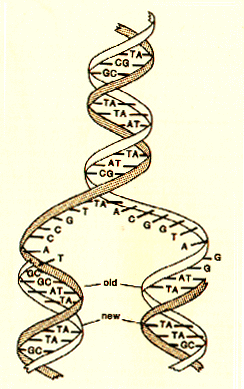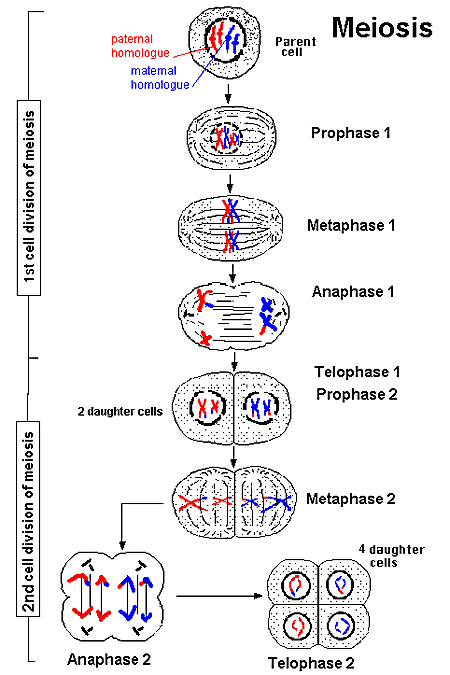DNA is a nucleic acid made up of phosphoric acid, deoxyribose, and a nitrogen base. Its form is that of the double helix, and it is made up Adenine, Thymine, Guanine, Cytosine.
DNA is the molecule of life.
For work on a paper published in an issue of Nature Magazine in 1956, Watson, Crick and Wilkins won the Nobel Prize for describing the structure of DNA and how it operated. Franklin identified the double helix arrangement through X-ray crystallography.
The two strands of the molecule are seperated with the help of enzymes. Each time DNA replicates, it creates an identical pair. In mitosis DNA replicates once and divides once so that the number of chromosomes in the offspring is the same as the parent.

- Chromatin?
Chromosomal material. - Chromosomes?
The structure in the cell nucleus or nuclear area where the genes are located. - Centromeres?
The center of the chromosomal strands. Also where the spindle fibers attach during mitosis or meiosis.
They vary.
- Interphase
Period during the cell cycle during which the cell grows and replicates its chromosomes in preparation for cell division. - Cytokinesis
The division of the cytoplasm to form two separate daughter cells immediately after mitosis.

Interphase-Not really a part of mitosis. The cell is in a state of metabolism.
Prophase-Chromatin shortens, thickens and nuclear membrane disappears.
Metaphase-Spindle fibers connect to chromatids as they migrate to equator of cells.
Anaphase-Chromatin is pulled apart.
Telophase-The cell becomes binuclear.
Cytokinesis-The "splitting"of the cell.
It is a process of duplicating and distributing genetic information which encourages diversity.

- Prophase 1: Each chromosome dupicates and remains closely associated.These are called sister chromatids.
- Metaphase 1: Homologous chromosomes align at the equatorialplate. Crossing-over can occur during this stage.
- Anaphase 1: Homologous pairs separate with sister chromatids remaining together.
- Telophase 1: Two daughter cells are formed with each daughter containing only one chromosome of the homologous pair.
- Prophase 2: DNA does not replicate.
- Metaphase 2: Chromosomes align at the equatorial plate.
- Anaphase 2: Centromeres divide and sister chromatids migrate separately to each pole.
- Telophase 2: Cell division is complete. Four haploid daughter cells are obtained.
- 2 divisions, meiosis I and II
- Four daughter cells produced with half as many chromosomes at parent cell.
- In meiosis DNA replicates once, divides twice.
- Meiosis occurs in gonads.

It is the process that creates hploid egg and sperm cells.
- fertilization
The union of male and female gametes, most often the sperm and the egg. - gametes
A reproductive cell that joins with another in fertilization to form a zygote; most often an egg or a sperm. - syngamy
Fertilization. Sexual reproduction by a union of gametes. - zygote
Diploid cell formed by the union of two gametes, the product of fertilization. - diploid
The 2N number of chromosomes. Twice the number found in gametes. - haploid
The N number of chromosomes; half the diploid number; the number characteristic of gametes that contain only one set of chromosomes. - Spindle Fiber
A microtubal structure that is a part of both mitosis and meiosis. - Cell plate.
Formed between the two nuclei during cytokinesis. - Cleavage Furrow
Where the split occurs in mitosis. - 1N
Containing half the normal number of chromosomes. Eggs and sperm are haploid. - 2N
Containing a full set of chromosomes, half of which were donated by the mother and the other half from the father. - clone
Asexually produced organisms having the same genetic makeup.